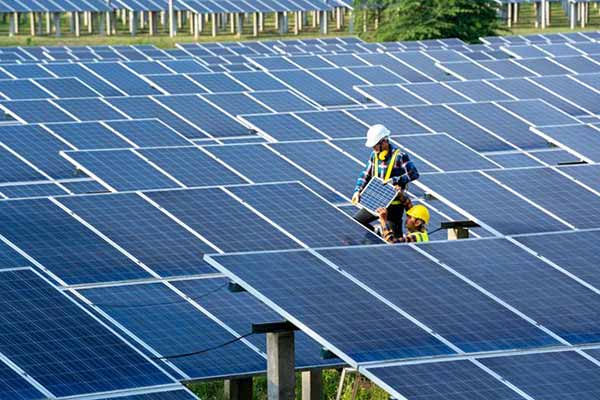Households throughout the U.K., including England and Scotland, are struggling with increasingly high fuel bills that industry officials say may soon lead to a “horrific” situation. Customer debt to energy suppliers is expected to grow by hundreds of millions of pounds, industry spokespeople said. They urged the government to intervene to help the most vulnerable. Meanwhile, New York state has approved the start of two major clean energy projects that are expected to substantially reduce carbon emissions while bringing billions of dollars in economic benefits.
Many U.K. Households in Danger of Fuel Poverty
The U.K. government has been warned that the effective increase of fuel prices brought about by adjustments to the price cap on energy this year could drive more than a third of the nation’s population into fuel poverty.
In April, the government made its first adjustment to the price cap, which has resulted in households facing bills that are nearly £600 ($783) higher than they previously paid. A second adjustment is planned for October, which is expected to result in an even bigger price increase.
Energy company executives told the government they feared the situation facing consumers during this year’s winter will be “horrific” and asked that something be done since they felt unable to cope with the situation.
Customer indebtedness to energy suppliers is expected to grow by £800 million ($1.04 billion) industry officials said, as more customers fail to honor their bills. Fuel poverty is defined as a household needing to spend 10% or more of its income on fuel, or as a household being left with so little funds to meet other needs after its spending on fuel that it could be considered as living below the poverty line.
As a consequence, the government has been urged to do more to help homeowners retrofit their homes to make them energy-efficient, which is expected to slash fuel bills by nearly a half. Energy firms have suggested that the government introduce a fund that would be used to reduce the fuel bills of vulnerable households by providing them with a £1,000 ($1,304) credit.
Throughout the United Kingdom, customers have been calling energy suppliers to express their fears over the price increases and their inability to pay them.
The government’s adjusting of the price cap has resulted in an average increase of just over 50% in energy bills for consumers, though the adjustment has brought some relief to energy companies. Several energy companies in the U.K. went out of business in the past year because the price cap, meant to protect consumers, prevented them from passing on the cost of soaring gas and oil prices to their customers.
One suggestion to deal with the crisis is that the government eliminate the cap system altogether — rather than adjusting it — in favor of one where the wealthier effectively subsidize the skyrocketing fuel prices.
An energy company in Scotland told parliamentarians that in just one week it had received calls from 8,000 Scottish consumers who feared they would be unable to meet their bills.
New York Powers Ahead With Renewables
New York state officials signed off on two renewable energy projects that are expected to help the state achieve 70% of its electricity generation from renewable sources by the end of the decade, on the path to its goal of a net-zero grid by 2040.
The two projects, Clean Path NY and Champlain Hudson Power Express, are also expected to result in benefits worth several billions of dollars, both economic and social.
It’s estimated the Champlain Hudson Power Express project will reduce carbon emissions by nearly 40 million metric tons within its first 10 years of operation, while providing year-round hydropower.
Clean Path NY comprises an infrastructure plan that includes several wind and solar projects, as well as a major underground transmission line. It’s hoped this project will deliver over 7 million megawatt-hours of clean energy annually.
Champlain Hudson Power Express involves transporting hydropower from Québec, Canada, to New York City, through a 545-kilometer (339 miles) transmission line. Hydro-Québec hopes to begin building the transmission line from Québec early next year, while its partner, Transmission Developers, will begin work on the line from the U.S. side in a few months. They hope the pipeline will be commissioned in 2025.
However, the hydropower project has proved controversial as some Indigenous groups have voiced strong objections over the potential impact of its dams on their territory’s environment.
New York state’s governor said the projects were an example of innovation to the world in confronting the “existential threat” that societies now face.
Other green energy initiatives successfully undertaken by New York include completion or initiation of 40% of energy-savings projects for state facilities, achievement of 5% of light-duty vehicles in the state’s fleet that are zero-emission, and 68% of state agencies using energy-efficient landscape designs.
TotalEnergies Pipeline Project in East Africa Loses Another Backer
Insurer Allianz Group has pulled out of the East African Crude Oil Pipeline project as activists keep up the pressure against the project being developed by the French company TotalEnergies and the China National Oil Corporation.
The pipeline that is receiving firm support by the governments of Uganda and Tanzania, through whose territories it will run, has been deemed a serious environmental hazard. Consequently, several banks and insurers, including BNP Paribas and Swiss Re, have declined to support it.
Activists in the two African countries say the pipeline will harm important water resources relied on by communities, as well as force the displacement of thousands of families to make room for it.
The $5 billion pipeline, which is over 800 miles long, will take crude oil from Uganda to Tanzania’s coast for export, beginning in 2025. More than 200,000 barrels of crude oil are expected to flow through the line each day. It’s expected to generate $2 billion in annual revenue and thousands of jobs for Tanzania and Uganda.
However, opponents say it will also create more than 30 million tons of carbon dioxide emissions each year.
The pipeline, which would provide an important export route for fuel from landlocked Uganda, has been opposed by more than 250 groups in Africa and by international organizations.
The governments of Tanzania and Uganda will hold a 30% interest in the pipeline.
Suppliers Helping Apple Cut Carbon Footprint
The electronics firm Apple announced that more than 200 of the companies that supply parts for its gadgets have committed to using renewable energy to power their production of those parts.
Currently, Apple’s suppliers use 10 gigawatts per year of renewable energy, and they have pledged to increase the amount of renewables used in their energy consumption to 16 GW.
Apple announced in 2020 that its plant operations had reached carbon neutrality. However, a company’s emissions also include those produced by its suppliers and the customers who use its end products. This latter type of emissions, known as Scope 3 emissions, represents a significant portion of the overall emissions produced by a company’s operations. The company says it hopes to achieve carbon neutrality for Scope 3 emissions by the end of this decade.
To achieve carbon neutrality, Apple also buys renewable energy credits from energy firms to offset the emissions produced in its operations when it’s been unable to substitute renewable energy in place of fossil fuels. Another 10% of emissions is compensated for by the company providing investment funding to renewable energy projects.
Price Jumps for Solar, Wind Power
After a decade of falling prices for renewable energy, the cost of solar and wind has begun to move up significantly.
A recent study showed that in both the U.S. and Europe, the cost of renewables contracts had risen almost 30%. Despite this, experts noted that the demand for renewable energy remains strong, because the alternative — namely, gas — has become prohibitively expensive.
Analysts fear the rise in prices for renewable energy could lead countries to slow down the energy transition, with unfortunate consequences for the climate. Among the factors contributing to the price increases are supply-chain disruptions and the effects of the war in Ukraine.
The determination by European countries to end reliance on fuel supplies from Russia has led to more demand for renewable energy supplies, contributing to the uptick in prices. At the same time, concerns in the U.S. over the solar industry’s dependence on Asia for solar panel imports have added to the difficulties.
French Firm Buys Stake in Trinidadian Green Energy Project
Trinidadian green energy firm Kenesjay Green Limited (KGL) has sold the majority stake in its green hydrogen project to French energy firm HDF Energy.
HDF Energy now owns 70% of KGL’s NewGen project, which will produce hydrogen from solar power and other sources to be used in Trinidad’s ammonia-production industry.
The $200 million NewGen project has received support from Trinidad’s Ministry of Planning. The project is considered an important aid to the country in helping its hydrocarbon-based economy achieve the clean-energy transition.
HDF already operates green hydrogen and solar power facilities in French Guiana and Barbados. The company said it believed Trinidad and Tobago’s energy industry offers an ideal opportunity for developing a competitive clean-hydrogen industry.
Opinion writer: Jewel Fraser
The opinions, beliefs, and viewpoints expressed by the various authors do not necessarily reflect the opinions, beliefs, or viewpoints of Interactive Energy Group, LLC (IEG) or its parent companies or affiliates and may have been created by a third party contracted by IEG. Any content provided by the bloggers or authors are of their opinion and are not intended to malign any individual, organization, company, group, or anyone or anything.
Brought to you by energysavings.com
All images licensed from Adobe Stock.
Featured image:



